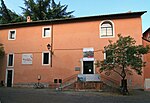Palazzo San Callisto
Palaces in RomePontifical Council Cor UnumProperties of the Holy See

The Palazzo San Callisto (also known as the Palace of Saint Callixtus) is a Baroque palace in the Trastevere neighborhood of Rome and one of the extraterritorial Properties of the Holy See. The original Palazzo is located in the Piazza di Santa Maria in Trastevere, the later extensions have their entrance in Piazza di San Callisto. The entire complex is one of the areas of the Holy See regulated by the 1929 Lateran Treaty signed with the Kingdom of Italy. As such it has extraterritorial status. In the courtyard of the palace is the well where, according to tradition, Pope Callixtus I was martyred in the year 222.
Excerpt from the Wikipedia article Palazzo San Callisto (License: CC BY-SA 3.0, Authors, Images).Palazzo San Callisto
Piazza di San Calisto, Rome Municipio Roma I
Geographical coordinates (GPS) Address External links Nearby Places Show on map
Geographical coordinates (GPS)
| Latitude | Longitude |
|---|---|
| N 41.8893 ° | E 12.4702 ° |
Address
Palazzo San Callisto
Piazza di San Calisto
00120 Rome, Municipio Roma I
Lazio, Italy
Open on Google Maps










